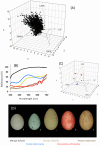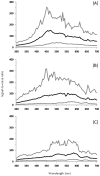Variability in avian eggshell colour: a comparative study of museum eggshells
- PMID: 20711258
- PMCID: PMC2918502
- DOI: 10.1371/journal.pone.0012054
Variability in avian eggshell colour: a comparative study of museum eggshells
Abstract
Background: The exceptional diversity of coloration found in avian eggshells has long fascinated biologists and inspired a broad range of adaptive hypotheses to explain its evolution. Three main impediments to understanding the variability of eggshell appearance are: (1) the reliable quantification of the variation in eggshell colours; (2) its perception by birds themselves, and (3) its relation to avian phylogeny. Here we use an extensive museum collection to address these problems directly, and to test how diversity in eggshell coloration is distributed among different phylogenetic levels of the class Aves.
Methodology and results: Spectrophotometric data on eggshell coloration were collected from a taxonomically representative sample of 251 bird species to determine the change in reflectance across different wavelengths and the taxonomic level where the variation resides. As many hypotheses for the evolution of eggshell coloration assume that egg colours provide a communication signal for an avian receiver, we also modelled reflectance spectra of shell coloration for the avian visual system. We found that a majority of species have eggs with similar background colour (long wavelengths) but that striking differences are just as likely to occur between congeners as between members of different families. The region of greatest variability in eggshell colour among closely related species coincided with the medium-wavelength sensitive region around 500 nm.
Conclusions: The majority of bird species share similar background eggshell colours, while the greatest variability among species aligns with differences along a red-brown to blue axis that most likely corresponds with variation in the presence and concentration of two tetrapyrrole pigments responsible for eggshell coloration. Additionally, our results confirm previous findings of temporal changes in museum collections, and this will be of particular concern for studies testing intraspecific hypotheses relating temporal patterns to adaptation of eggshell colour. We suggest that future studies investigating the phylogenetic association between the composition and concentration of eggshell pigments, and between the evolutionary drivers and functional impacts of eggshell colour variability will be most rewarding.
Conflict of interest statement
Figures





Similar articles
-
Not so colourful after all: eggshell pigments constrain avian eggshell colour space.Biol Lett. 2015 May;11(5):20150087. doi: 10.1098/rsbl.2015.0087. Biol Lett. 2015. PMID: 25994009 Free PMC article.
-
Pigment concentrations only partially predict avian eggshell colour mimicry in a polymorphic host-brood parasite system.Biol Lett. 2025 Jun;21(6):20250112. doi: 10.1098/rsbl.2025.0112. Epub 2025 Jun 11. Biol Lett. 2025. PMID: 40494396
-
Surface texture heterogeneity in maculated bird eggshells.J R Soc Interface. 2023 Jul;20(204):20230293. doi: 10.1098/rsif.2023.0293. Epub 2023 Jul 12. J R Soc Interface. 2023. PMID: 37434502 Free PMC article.
-
The diverse terminology of reptile eggshell microstructure and its effect on phylogenetic comparative analyses.J Anat. 2022 Sep;241(3):641-666. doi: 10.1111/joa.13723. Epub 2022 Jun 27. J Anat. 2022. PMID: 35758681 Free PMC article. Review.
-
[Progresses in inheritance of genes for avian eggshell color].Yi Chuan. 2007 Mar;29(3):265-8. doi: 10.1360/yc-007-0265. Yi Chuan. 2007. PMID: 17369144 Review. Chinese.
Cited by
-
Endogenous retrovirus EAV-HP linked to blue egg phenotype in Mapuche fowl.PLoS One. 2013 Aug 19;8(8):e71393. doi: 10.1371/journal.pone.0071393. eCollection 2013. PLoS One. 2013. PMID: 23990950 Free PMC article.
-
A nanostructural basis for gloss of avian eggshells.J R Soc Interface. 2015 Feb 6;12(103):20141210. doi: 10.1098/rsif.2014.1210. J R Soc Interface. 2015. PMID: 25505139 Free PMC article.
-
Eggshell pigment composition covaries with phylogeny but not with life history or with nesting ecology traits of British passerines.Ecol Evol. 2016 Feb 12;6(6):1637-45. doi: 10.1002/ece3.1960. eCollection 2016 Mar. Ecol Evol. 2016. PMID: 26904185 Free PMC article.
-
Pigmentation of White, Brown, and Green Chicken Eggshells Analyzed by Reflectance, Transmittance, and Fluorescence Spectroscopy.ChemistryOpen. 2019 Jul 23;8(8):1084-1093. doi: 10.1002/open.201900154. eCollection 2019 Aug. ChemistryOpen. 2019. PMID: 31406655 Free PMC article.
-
The chemical basis of a signal of individual identity: shell pigment concentrations track the unique appearance of Common Murre eggs.J R Soc Interface. 2019 Apr 26;16(153):20190115. doi: 10.1098/rsif.2019.0115. J R Soc Interface. 2019. PMID: 30966949 Free PMC article.
References
-
- Cott HB. London: Methuen; 1957. Adaptive coloration in animals, 1st ed. reprinted with minor corrections.508
-
- Bennett ATD, Théry M. Avian color vision and coloration: multidisciplinary evolutionary biology. Am Nat. 2007;169:S1–S6.
-
- Wallace AR. London: Macmillan; 1889. Darwinism: An exposition of the theory of natural selection with some of its applications.494
-
- Lack D. The significance of the colour of turdinae eggs. Ibis. 1958;100:145–166.
-
- Underwood TJ, Sealy SG. Adaptive significance of egg coloration. In: Deeming DC, editor. Avian Incubation: Behaviour, Environment, and Evolution. Oxford: Oxford University Press; 2002. pp. 280–289.
Publication types
MeSH terms
LinkOut - more resources
Full Text Sources
Molecular Biology Databases
Research Materials

